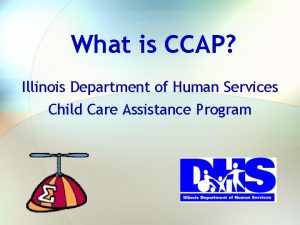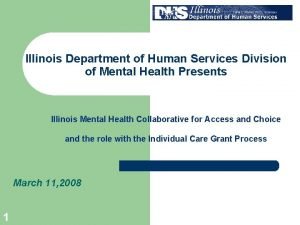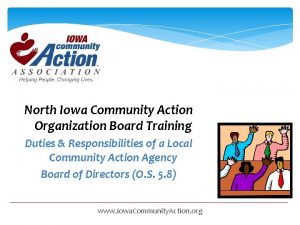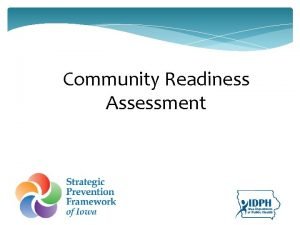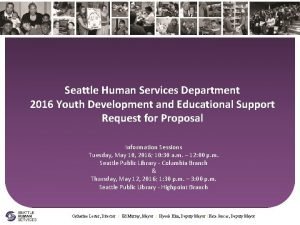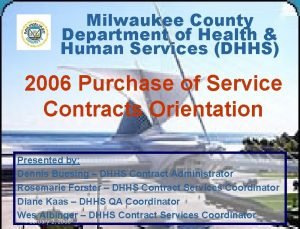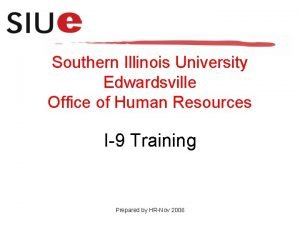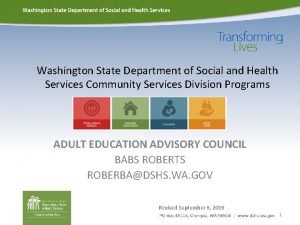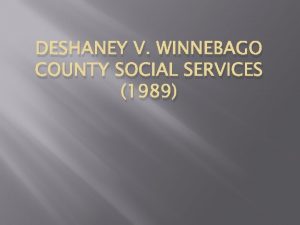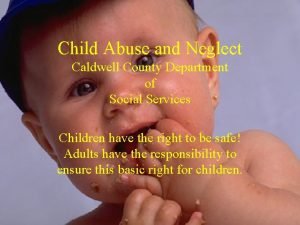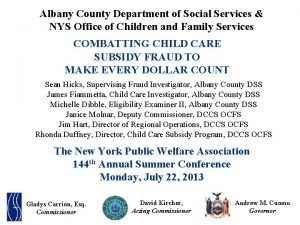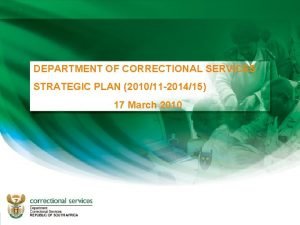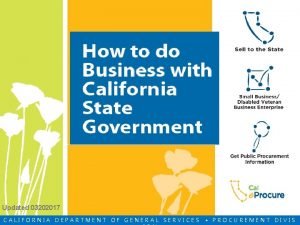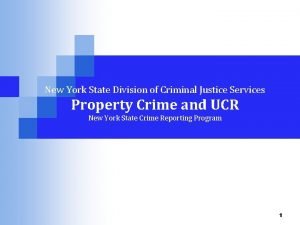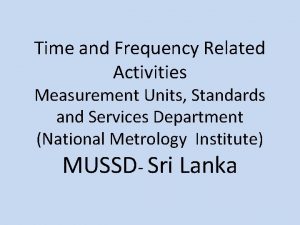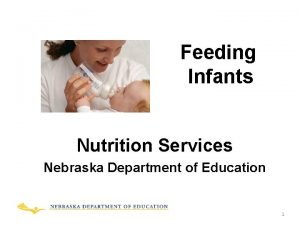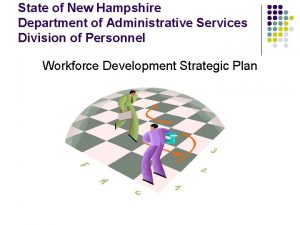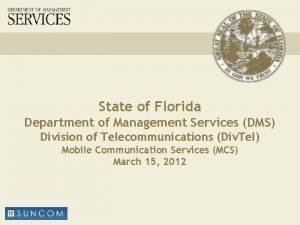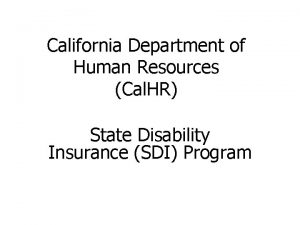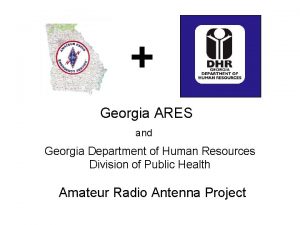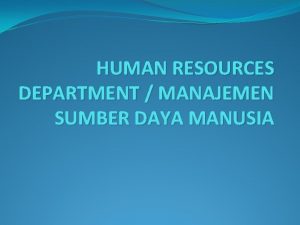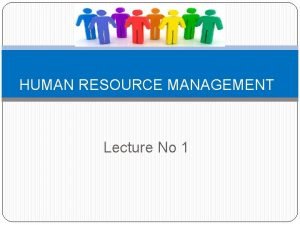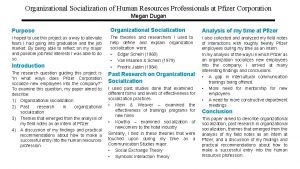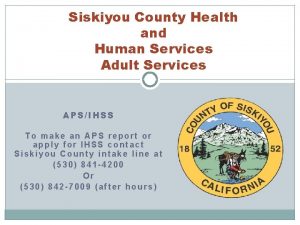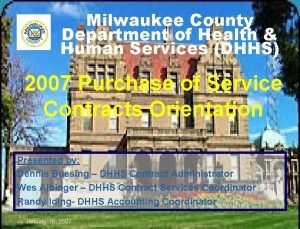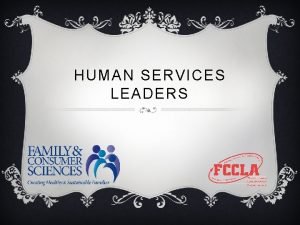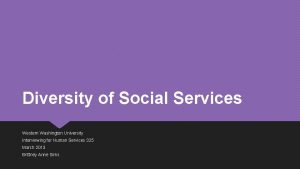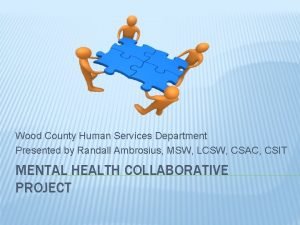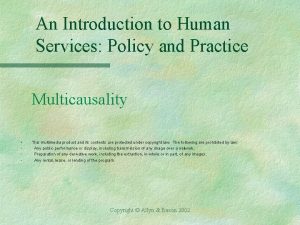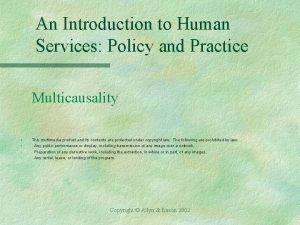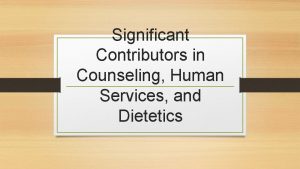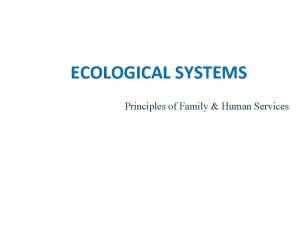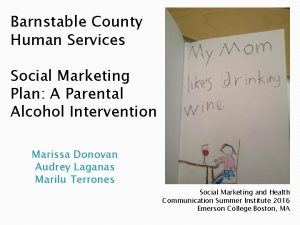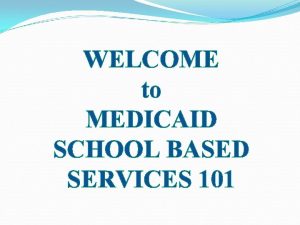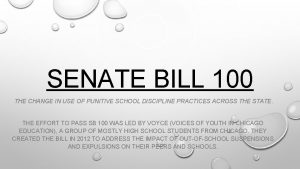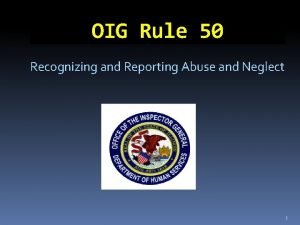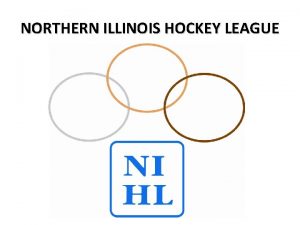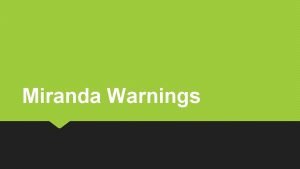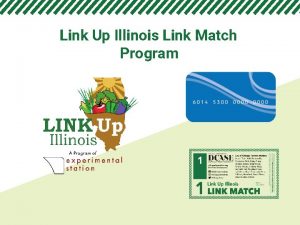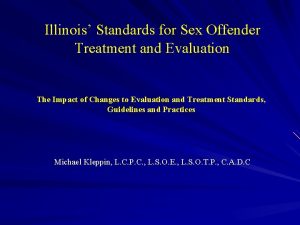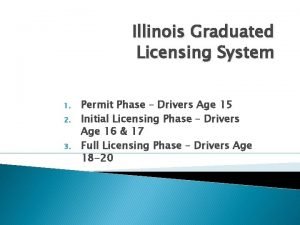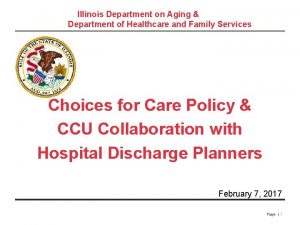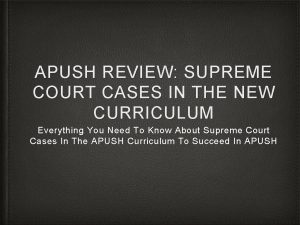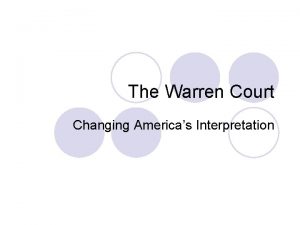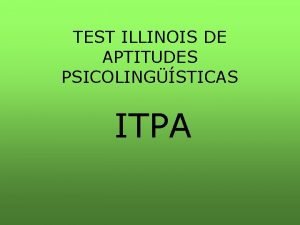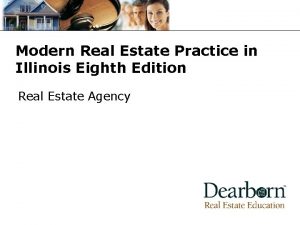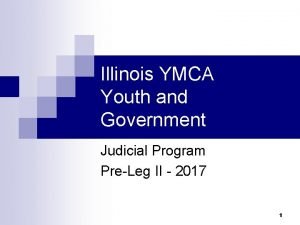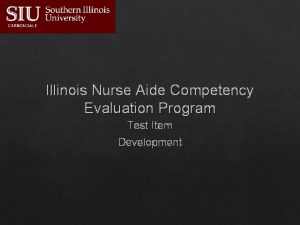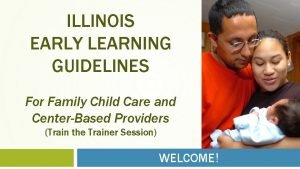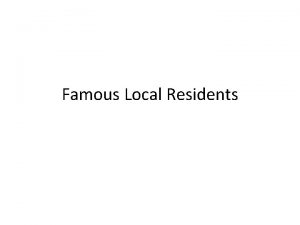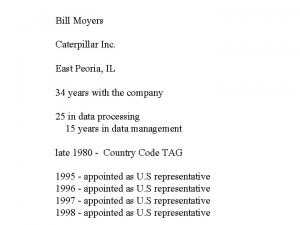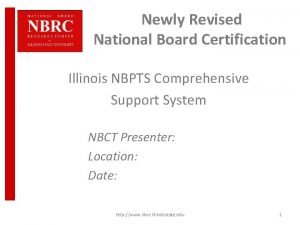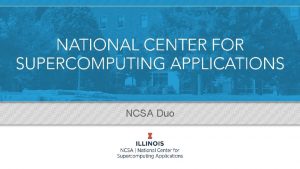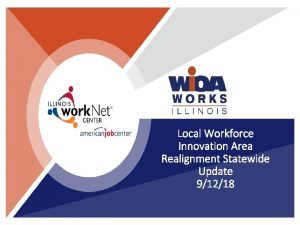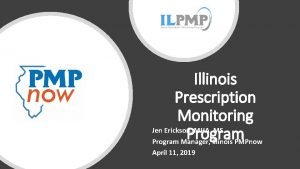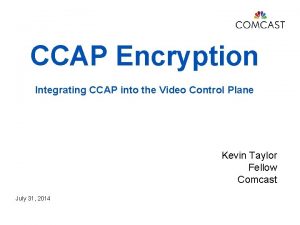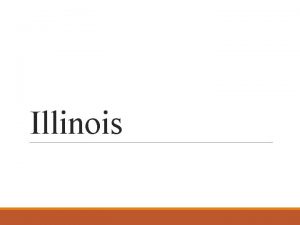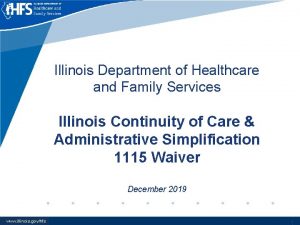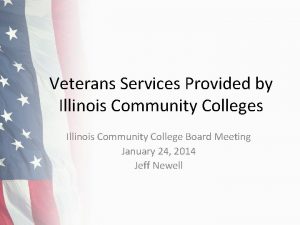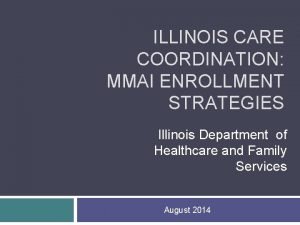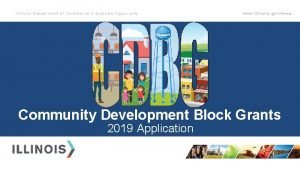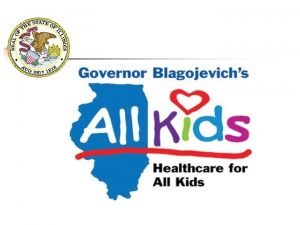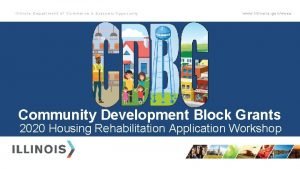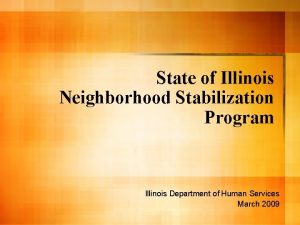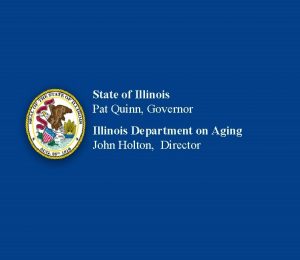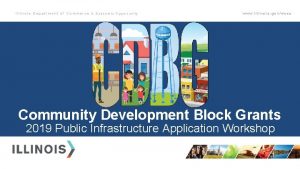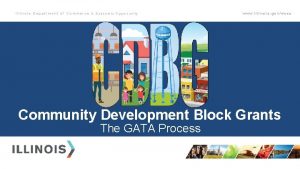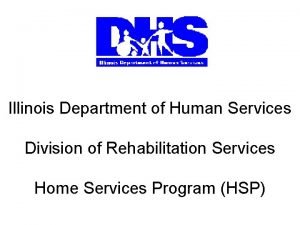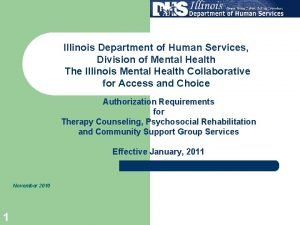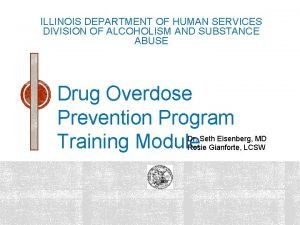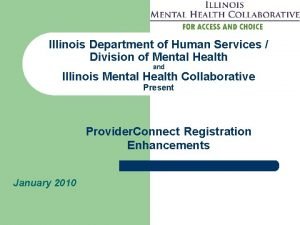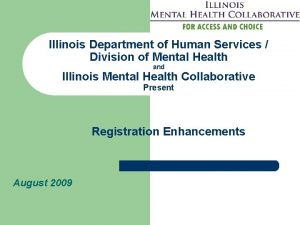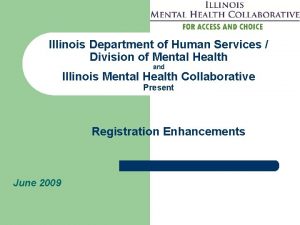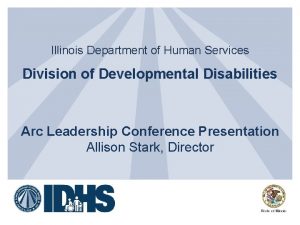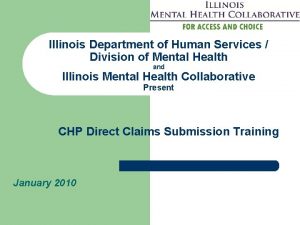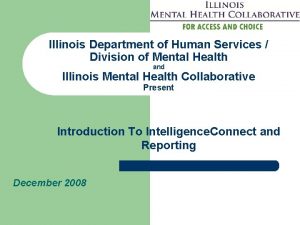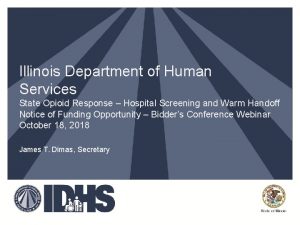What is CCAP Illinois Department of Human Services



























































































- Slides: 91

What is CCAP? Illinois Department of Human Services Child Care Assistance Program

Learning Objectives Become familiar with IDHS Child Care Assistance Program policy concerning: § § § CCAP Overview Provider Qualification Application Process Payment Process Parent Co-payments Other Issues

Child Care Assistance Program The Illinois Department of Human Services Child Care Assistance Program – helps pay for child care expenses for income-eligible families who work or go to approved school or training

IDHS CHILD CARE ASSISTANCE PROGRAM Two Delivery Systems Certificate Program Site Program • Managed by Child Care • Managed by Site Administered Child Care Centers Resource and Referral (CCR&R) Agencies • Payments for all types of legal child care providers • Centers are paid directly through IDHS

IDHS CCAP Family Eligibility Guidelines • Parents/Guardians must be Illinois Residents, • Must meet the income guidelines of the program; • Must be employed or enrolled and participating in an approved education or training program or involved in a TANF-approved activity or a combination of any of the above; • Child must be under the age of 13 year(unless special needs can be documented to continue the care beyond the age of 13 years)

Family Eligibility Determination pr Ap ed v o • Eligibility can only be determined by the CCR&R or contracted Site Administered child care centers. D en ie RA I it l i b igi l E y Child Care d • The provider must decide if they will provide care before the case is approved and how or if to charge the parent while eligibility is being determined. • Non-contracted child care providers cannot determine if a family is eligible for the assistance program.

Eligibility Calculator • Families and providers can get an estimate of the parent’s share of the cost of care, known as the Parent Co-payment, by using the Child Care Assistance Program Eligibility Calculator on the web at: http: //www. dhs. state. il. us/applications/Child. Care. Elig. Calc/eligcalc. html • Note: Only the CCR&R or Site provider can calculate the Total Monthly Income that will be used for determining eligibility for the program

Family Eligibility Guidelines A more complete explanation of CCAP eligibility can be found in the “CCAP Program Manual” located at: www. dhs. state. il. us/page. aspx? item=9877 Check it out!!!

Types of Legal Care Arrangements • Licensed Day Care Center (760) • Day Care Center Exempt from licensing (761) • Licensed Day Care Home (762) • Licensed Group Day Care Home (763)

Types of Legal Care Arrangements (cont. ) • Day Care Home Exempt from Licensing (764) • Relative Exempt from Licensing (765) Care in the home of the provider • Non-relative Exempt from Licensing (766) Care in the home of the child • Relative Exempt from Licensing (767) Care in the home of the child

License Exempt Homes (764, 765, 766, 767 types of care) A provider who is not licensed, who provides care in their own home or in the home of the child, can care for no more than three children, including the provider’s own children, unless all the children are from the same biological parent and the same household.

License Exempt Home Examples of Capacity Providers can care for six children from one household. Providers can care for two children from one household and one from a second household.

License Exempt Home Examples of Capacity Providers cannot care for two children from one household and two from a second.

Provider Information • Providers cannot be a parent, stepparent, adoptive parent or legal guardian of the child; • Providers cannot be a person living in the home who is a parent of the child's sibling or has a child in common with the applicant; • Providers cannot be a member of the parent’s TANF unit; • Providers cannot have certain criminal convictions or be indicated by the Illinois Department of Children and Family Services (DCFS) Child Abuse and Neglect Tracking System (CANTS); • Providers must be 18 or older

License Exempt Homes • Providers caring for children in their home are NOT eligible for child care for their own children.

Parents Employed by a Legal Care Provider • The need for an assistant is verified with a DCFS licensing representative • All assistants must clear the Illinois State Police and Sex Offenders Registry Background Check and a CANTS Check • The provider must keep records of these checks • Employment must be documented with pay records • There must be a need for child care services

Provider Registration for License Exempt Homes License exempt homes MUST provide clear copies of: • Current Driver License (front and back) or a, • Current State ID or a, • Current Military ID and, • Social Security Card

License Exempt Centers • Child care facilities and programs must meet certain conditions in order to qualify as exempt from licensure. • A child care center not licensed by the State of Illinois must certify its program is exempt from licensure by submitting a License Exempt Day Care Center Self-Certification form.

License Exempt Centers • If a parent submits an application or redetermination that indicates their child attends a license exempt day care center, the CCR&R will verify the provider status in the IDHS system. • The center will need to complete a License Exempt Child Care Center Self-Certification form (IL 444 -3461) if the provider has not completed the form for another case in the past.

License Exempt Centers • At the discretion of the Department of Human Services, the center may be asked to furnish a letter from the Department of Children and Family Services (DCFS) that verifies the center's exempt status. • If the provider marks the 9 th exemption on the form, the facility must attach written verification from the local DCFS licensing office.

Provider Certification When signing the child care application, the provider is agreeing that they will comply with certain requirements, including but not limited to: • Physical exam • Developmentally appropriate play activities • TB skin test • Children supervised at all times • No accessible hazardous material, firearms or ammunition • Maintain all records for five (5) years • First aid supplies • Make records available to IDHS • No corporal punishment • No incorrect or fictitious SSN

Authorization for Background Check (ABC) Form • In order to be paid by the state, all providers must complete an Authorization for Background Check (ABC) form • All persons age 13 and older in the provider’s home where care is being given may be subject to background checks • If an ABC form is not submitted, or if the provider or any individuals in the home are indicated, a 10 day cancellation notice will be issued. • Sections 1, 2 and 4 MUST be completed by the provider

Background Checks • CCR&R staff must verify that the provider has cleared the required checks • If not, CCR&R staff must send instructions, an Authorization for Background Check form, and a screen print from the DCFS Fingerprint Database to the provider

Background Checks Providers must follow the instructions within the given timeframes in order to be approved to receive payments from the State.

Missing SSNs • If the provider and/or household member does not have a Social Security Number, or if an individual refuses to provide a social security number, the background check process cannot be completed and the provider will be denied.

DCFS Background Check Unit After the CCR&R forwards the form to DCFS, their Background Check Unit will: 1. DCFS will perform a Child Abuse and Neglect Tracking System (CANTS) check on the provider for indicated reports of abuse or neglect. 2. DCFS will perform a check of the Illinois and National Sex Offender Registries.

DCFS Background Check Unit (continued) 3. For non-relative providers and employees of a license exempt center, DCFS will confirm and compare whether a criminal conviction record sent by the State Police and/or FBI is listed as a bar for: Operating as a license exempt child care provider, or Employee in a license exempt child care facility 4. DCFS will record the result of PASSED or FAILED for each type of check on the ABC form 5. DCFS will return the ABC form to the appropriate CCR&R with a PASS/FAIL indication for each relevant check

Re-Fingerprinting • DCFS will send written notice to the CCR&R indicating the name of individuals whose fingerprints are not legible or are otherwise impossible to check. • The CCR&R must contact the individual to request the need for a reprint. • The individual is required to present a copy of the DCFS notice to the fingerprint vendor for the re-fingerprinting to occur.

Challenges to CANTS Findings Challenges to CANTS findings must be made in writing to the: Illinois Department of Children and Family Services State Central Register 406 E. Monroe - Station #10 Springfield, IL 62701

Challenges to Criminal History Findings Challenges to criminal history findings must be made in writing to the nearest Illinois State Police or the FBI Office.

W-9 Form • The State requires all providers to certify their Social Security or FEIN numbers through the W-9 Form process. • Sign the W-9 Form exactly the same as it is entered on the name line. • Review the form carefully before sending to the CCR&R. If the information is not legible, or if all applicable boxes are not filled in, payment will be delayed.

Type of Business • Providers must indicate the type of business they are legally operating (sole proprietor, corporation, partnership, or other). • If “other” is selected, an explanation must be given. • Most home providers are sole proprietors unless they have formed a corporation or a legal partnership with another entity or person

The Application Process • Families seeking assistance must complete a Child Care Application. • The Child Care Application Form (3455) is available at IDHS Family Community Resource Centers, Site Administered Child Care Centers, and/or CCR&R’s. • You can also download the Application from the web: www. dhs. state. il. us/page. aspx? item=30355

The Application Process • All Applications must be signed by both the parent and the provider before it is submitted to the Site or sent to the CCR&R for processing. • Eligibility may begin up to seven days prior to the date the CCR&R or Site received the application or on the date of the applicant’s signature, whichever is later.

How Long Does the Application Process Take? The parent/guardian and provider will receive one of three forms within 45 days of the CCR&R or Site receiving the completed Application and required documentation: − A Denial, or − An Approval, or − A Request for Additional Information (RAI)

Parent/Guardian's Responsibility • It is the applicant's • Providers may assist the responsibility to parent in completing the provide the CCR&R application process but the or Site written parent/guardian must documentation communicate with the required to establish CCR&R regarding their initial or eligibility documentation continued eligibility

Schedule and Rate-Application • The Provider and Parent must complete Section 4 (p. 8 & 9) of the application together • Care schedule must be reasonably related to the parent’s activity schedule • The Provider must enter the daily rate that will be charged for each child

LEGAL CARE ARRANGEMENTS • Providers must complete and sign their portion of the Application form and check the box that best describes the type of care they will be providing. • Providers that are licensed through DCFS, must enter their license number, capacity, expiration date, and hours of operation. Providers Signature and Date

Verification of Family Information • Information submitted by the parent/guardian on the application and supporting documentation is verified through various agency databases such as: NS TIO A C I F I VER • TANF amps St • Food al y • Medic ment Securit y • Emplo bor a L f O dmin. A • Dept. y t i r ent cu e m S e l c r a i o • Soc rt Enf o p p u S • Child

If the family is approved, both the Parent and Provider will receive a Notice of Approval. • Child Care Case Number • Parent /Provider Information • Reason for Child Care • Eligibility Period • Parent Co-payment Amount • Names of Eligible Children • Number of Days Per Week (full or part-time or school age care) • Daily Rate Amount • Comment Area

Redeterminations • Most cases have their eligibility reviewed for continued eligibility at least every six months. − This is called a Redetermination • Families must provide most of the same documentation as when they applied. • If the client does not send in the updated information, or is determined to be ineligible for the program, the client and the provider will receive a Notice of Cancellation.

Grace Periods and Leaves For Active CCAP Families • Job Search − 30 days from loss of employment to look for a new job. CCR&R or Site must be notified at beginning of each search period • Semester Breaks − 30 days from the last day of semester for college students who are eligible for the next semester • College Graduation − 30 days from graduation for job search Only three (3) grace periods are allowed in a 12 -month period The CCR&R or Site MUST be notified within 10 days of the change in order to be eligible for a grace period.

Grace Periods and Leaves For Active CCAP Families • Medical Leave − Six weeks per leave with proper documentation − MUST be returning to the same job after the leave • Maternity Leave − Six weeks per leave with proper documentation − Starts on the date of delivery − MUST be returning to the same job after the leave Note: The parent can request a Medical Leave for medical complications associated with pregnancy prior to the delivery.

Payment Process • Monthly computer-generated billing forms will be sent each month from IDHS • Enter the total number of days (full or part time or school age) of care provided for each child • The provider is responsible for maintaining daily attendance records/sign-in sheets which can be requested by IDHS at any time within five years It is important to keep these records to verify that care was provided for the days that were billed.

Payment Process (cont…) • Providers should never bill for days when a child was not in attendance or when a center or home was closed • Centers must list the number of days open during the month on the certificate • The CCR&R begins processing the certificates on the first working day of each month following the month of service • The Illinois Comptrollers Office writes and mails the checks (warrants)

Payment Process (cont. ) • After a payment is entered (either by the CCR&R or through the Telephone Billing System, explained later), the payment then goes to DHS Vouchering Unit for approval, then to Illinois Comptroller, who issues the payment. • Direct Deposit and Debit Card payments should be available 2 business days after payment is issued by the Comptroller.

Payment Process (cont. ) • The payment process from beginning to end takes about three weeks • It can take four to eight weeks to receive the first payment (This is due to processing the W-9 form at the Illinois Office of the Comptroller) • Having your name on your mailbox will help with delivery of your check

Payment Process (cont. ) Taxes are not deducted from child care payments. Providers will be sent an IRS Form (1099 -Misc) for earned income of $600 or more for tax reporting purposes.

Center Certificate Reports Only • Be sure to use the correct code for adjusted eligible days: • Enter code in the next to last column of the form • Enter the dates that the event occurred in the last column Be sure to read and follow the instructions on the Certificate Report.

Center Certificate Reports Only • Total the number of attended days and the number of adjusted eligible days at the bottom of each page: • Include the total of all eligible days being counted. • If no adjustment was made to the number of eligible days, the preprinted number of days should be added.

Home Billing Certificates Only • If care was provided for more than the approved number of days – An explanation must be given on the back of the certificate. • The home provider and parent/guardian must sign the certificate and return it to their local CCR&R office.

80% Attendance Rule - Centers Calculation Procedures • Add the eligible days for ALL IDHS funded children at a location on the certificate report • Add the attended days for ALL IDHS funded children at a location on the certificate report • Divide the attended days by the eligible days • If the percentage is 79. 5% or higher, all children will be paid for the eligible days • If the percentage falls below 79. 49%, each family will be paid for the attendance percentage

80% Attendance Rule - Licensed Homes Calculation Procedures • Add the eligible days for ALL children in an IDHS funded family • Add the attended days for ALL children in the IDHS funded family • Divide the attended days by the eligible days • If the percentage is 79. 5% or higher, all children will be paid for the eligible days • If the percentage falls below 79. 49%, all children will be paid for the number of days they attended

80% Attendance Rule • Do not count eligible days if a child did not attend any days of a type of care: full-time, part-time, or school-age. • License-exempt homes are paid for days attended only.

Attendance Exemptions – Licensed Centers Only • Eligible days may be adjusted if more than 50% of enrolled children do not attend on a given day due to: − Natural disaster, Mechanical breakdown, Snow days, Epidemics or Other extraordinary events • Contact IDHS at (217)-524 -5832 within five days of event. • Complete and return an Attendance Exemption Request form with documentation to IDHS within 10 days of event. − Fax to 217 -557 -4717

Additional Child Care Costs IDHS will not pay for the following fees: • Time the parent did not give the provider notice that they would no longer be attending • Parent co-payment • Registration or enrollment fees • Summer camp activity fees • Recreation fees • Field trips fees • Activity fees • Late fees • Tuition

Child Care Daily Rates • Less than five hours = Part day rate • Five hours through twelve hours = Full day rate • Less than five hours for child in school= School-age rate • More than 12 hours – contact the CCR&R for instructions • The maximum rate IDHS will pay for each type of provider and day are located on the IDHS web site at: http: //www. dhs. state. il. us/page. aspx? item=10864

More on Rates • Providers are encouraged to accept the State rate for families using CCAP • If a provider charges more than the State rate, the parent is responsible for the additional amount • Providers cannot charge subsidized parents/guardians more than private pay families

Quality Counts Quality Rating System (QRS) QRS is a voluntary system available to providers who meet specific indicators of quality care. Providers who meet required criteria are awarded a QRS Award Certificate. Providers caring for children eligible for CCAP will receive a quality add-on rate to help pay for the higher cost of providing quality care.

Provider Types Who Can Apply for the QRS v License-exempt Family Child Care Homes. v Licensed Family Child Care Homes & Group Homes. v Licensed Centers & Licensed School-Age Programs. - Licensed Homes and Centers must care for children full day (8 or more consecutive hours) and operate a minimum of 9 months per year. - Licensed School-Age programs must care for children a minimum of 9 months per year.

License-Exempt Center Based Programs v. License Exempt Centers must become licensed to apply for QRS. v. The local CCR&R can provide information on licensing, as well as provide information on funds available to assist in meeting licensing standards.

How Does the QRS Work? • License Exempt Home Providers can be approved for one of three tiers based on the number of hours of training they have received. • Exempt Home Providers that are serving children eligible for CCAP receive a quality add-on from 10%-20%, depending on the level of training they have taken.

How Does the QRS Work? • Licensed providers can be awarded 1 -4 star levels based on various criteria. • Those receiving CCAP payments receive a quality add-on from 5%-20%, based on the number of stars they are awarded. • Each tier/level builds upon the previous level.

Getting Started v Attending the QRS Orientation is required of any provider who applies to the QRS. v All providers need to attend required training prior to applying to the QRS. v There is currently no application fee for the QRS. v Check with your local CCR&R for QRS Orientation schedules and to learn more. v See more about QRS on the web at: http: //www. inccrra. org

Check Payment Status • To determine the status of your payment, you can • Call the Provider Line at: (800) 804 -3833 • Go to http: //www 2. dhs. state. il. us/PPI/ppi. aspx • The provider TIN (SSN or FEIN) and the IVR case number are required • These services are available 24/7 and provide information on the status of your current payment • This information is updated once each day so there is no need to check more than once a day

Telephone Billing System for Home Child Care Providers • You will need a special password in order to access the system: • Issued after you have submitted the Child Care Telephone Billing Agreement form sent at the time of your approval • You must still complete the paper certificate and both the parent/guardian and provider must sign • Do not mail to the CCR&R unless told to by the system • Keep the signed certificate for five years • If you have any problems with the billing system, contact your CCR&R

Why Use the Telephone Billing System? • The State’s payment system receives the information faster • No mail delays in getting information to the CCR&R • The payment information may be entered seven days a week, twenty-four hours a day • The provider gets immediate confirmation that their payment has been entered • Information is posted on the Payment Inquiry Line two days after entry

Direct Deposit • Using Direct Deposit will get your payment even faster • For more information, visit the State Comptroller’s website at: http: //www. ioc. state. il. us or call 217 -557 -0930 • To check the status of your payment, go to: http: //www 2. dhs. state. il. us/PPI/ppi. aspx - enter your SSN or FEIN.

Illinois Debit Master. Card • CCAP payments can be deposited to the Illinois Debit Master. Card account by the Illinois Comptroller’s office. • Providers must complete an Illinois Debit Master. Card Payment Option Form in order to receive payments on the debit card • The Illinois Debit Master. Card Payment Option Form can be downloaded at: http: //www. dhs. state. il. us/page. aspx? item=45466

Who Can Use the Debit Card? • CCAP Family Home Child Care Providers (Licensed and License Exempt) − Using their own name. • DBA’s are only acceptable if the provider is using their own name for payment and their company name in the DBA line

Benefits Of The Illinois Debit Card Payments are available faster, therefore you can: • Get cash faster • Shop faster • Receive notice by phone of payment • Access toll-free customer service • Receive monthly statements • Access information in a safe and secure way

Debit Card Customer Service Available 24 -hours a Day, 7 Days a Week 1 -866 -338 -2944 www. eppicard. com • Check balance. • Select or change Personal Identification Number (PIN). • Review history of transactions. • Ask questions about card use. • Disagree with a transaction. • Report lost, stolen, and damaged cards. • Get notification of deposits.

Convenience The Illinois Debit Master. Card is accepted at merchant and bank locations worldwide. Providers can use their card wherever the debit Master. Card acceptance mark is displayed. Master. Card® and the Master. Card® Brand Mark are registered trade marks of Master. Card International Incorporated.

Co-payments • Co-pay amounts are listed on the Approval and the Billing Certificate. • It is the responsibility of the provider and parent to decide if the fee should be collected monthly or weekly. • To determine the weekly amount, divide the monthly co-payment amount by 4. 333.

Co-payment Collection • Providers are required to collect the assessed co-payment amount. • In the interest of “Best Business Practice” have a contract signed by the parent listing fee payment information. • Co-payment collection methods are between the parent and provider. §The CCR&R does not play a role.

Co-payment Collection • In the interest of “Best Business Practice” IDHS recommends that providers collect co -payments before service is provided. • Providers may follow fee collection policies they have for private pay families.

Co-payments and Multiple Providers • Only one provider will be assigned the co-payment − Check the approval letter and billing certificate • The provider who collects that co-payment will have the assessed amount deducted from their payment • The provider not collecting the co-payment will be paid the full amount by the State

Co-payments and Change of Providers • Families shall pay their monthly co-payment to the provider that is approved on the first day of the month. • Consequently, if a family changes providers any time after the first day of the month, the first provider shall collect the whole monthly copayment.

Co-payments and Change of Providers • If charges for care less than the monthly co-payment, the provider shall collect the smaller of the two amounts. • The new provider will not collect a co-payment until the first of the following month.

Change of Information The CCR&R must be notified within ten days of any changes: Provider Changes: − Address − Name/DBA − Rates − TIN (SSN/FEIN) − Type of care − Ending care Parent Changes: − Family size − Income − Hours − Activity − Marital status − Address Change − Name Change

Provider Responsibilities Recap • Complete and sign their portion of the application • Complete all forms required for provider certification (Background Check, W-9. . . ) • Get fingerprinted within the given time when requested • Submit copies of ID and SSN card when requested • Maintain attendance and billing records for all children in their care • Notify the CCR&R of any pertinent changes in approved child care arrangements within 10 days • Be responsible for collecting the Parent co-payment • Report child care payment income to IDHS or CCR&R (if the provider receives IDHS benefits for themselves) and the IRS

Legal Issues • Confidentiality − Information collected about the families and providers of the program will be used only for purposes directly related to the administration of the IDHS Child Care Assistance Program • Taxes − Taxes are not withheld from payments made to providers − An IRS Form (1099 -Misc) for earned income will be sent to all providers earning more than $600, for use when filing tax returns − CCR&Rs offer trainings on tax issues for child care providers

Legal Issues • IDHS and its contractors may conduct investigations when improper payments may have occurred • If you suspect a parent/guardian of committing intentional program violations, contact your CCR&R • If a parent or a provider causes an improper payment, IDHS will seek repayment of funds

Overpayments • If it has been determined that a parent/guardian or provider is responsible for repayment of an improper payment, an overpayment notice will be issued with instructions for repayment. • If a provider does not respond to notices of overpayments, all payments for all IDHS families will be stopped until a repayment plan has been established.

Problem Resolution • If a parent/guardian has an issue about how a case has been managed, or about CCAP in general, they should first contact the local CCR&R. • If resolution cannot be reached at the CCR&R contact the IDHS Child Care Complaint Unit at 217 -524 -5832.

Appeals • Parents/guardians have a right to appeal unfavorable decisions made about their case. • Appeals must be filed within 60 days of the notice of the unfavorable decision. • Contact the CCR&R or IDHS to file the appeal: (800 -435 -0774)

Provider Appeals • If the provider wants to file an appeal, the CCR&R will: − Explain they can only appeal decisions about payments − Explain how the decision was made − Send the provider an Illinois Court of Claims Form (CC-28. 2) Please note: Home providers have the option of contacting SEIU

Other CCR&R Services • Child Care Business Information, Newsletter and Lending Library • Quality Counts Van • Training and Conference Opportunities • Free Referral to Parents • Quality Rating System (QRS) Information • Infant/Toddler Child Care Specialist • Licensing Information • Gateways Scholarship Program • Gateways to Opportunity Professional Development System • Great START Wage Supplement Information • Child Care Nurse Consultants • Mental Health Consultants

Resources • See the IDHS Child Care Program Handbook for detailed policy on these and other issues at: http: //www. dhs. state. il. us/page. aspx? item=9877 • The What Is CCAP? Handbook will also provide: − − Definition of common terms Provider Tips Frequently Asked Questions Forms

Application Provider CCR&R Determines Eligibility Illinois Department of Human Services Child Care Assistance Program IDHS Prints Forms Comptrollers Prints Check CCR&R Enters Certificate Provider Completes Certificate Approval & Certificate

Thanks for Attending. . . and for all that YOU do for the children and families of Illinois!!
 Ccap
Ccap Illinois mental health collaborative
Illinois mental health collaborative Ccap california community college
Ccap california community college North iowa community action
North iowa community action Iowa department of health and human services
Iowa department of health and human services Seattle human services department
Seattle human services department Milwaukee county human services
Milwaukee county human services Maine department of health and human services
Maine department of health and human services Delaware county human services
Delaware county human services Illinois department of rehabilitation
Illinois department of rehabilitation Wake county human services community services center
Wake county human services community services center Illinois health care services lien act
Illinois health care services lien act Siue hr forms
Siue hr forms City of worcester inspectional services
City of worcester inspectional services Washington state department of social and health services
Washington state department of social and health services What are the elements of a system of care
What are the elements of a system of care Florida dept of agriculture and consumer services
Florida dept of agriculture and consumer services Deshaney v. winnebago county social services (1989)
Deshaney v. winnebago county social services (1989) Caldwell county dss
Caldwell county dss Albany county department of social services
Albany county department of social services Bidsync miami dade
Bidsync miami dade Department of correctional services strategic plan
Department of correctional services strategic plan Virginia department of agriculture and consumer services
Virginia department of agriculture and consumer services California department of general services
California department of general services Department of criminal justice services ny
Department of criminal justice services ny Mussd
Mussd Department of health and senior services missouri
Department of health and senior services missouri Cacfp nebraska
Cacfp nebraska New hampshire department of administrative services
New hampshire department of administrative services Dms state of florida
Dms state of florida Swot analysis for human resource department
Swot analysis for human resource department Management fifteenth edition
Management fifteenth edition Swot analysis of hr department
Swot analysis of hr department Calhr holiday credit
Calhr holiday credit Georgia department of human resources
Georgia department of human resources Human resources department adalah
Human resources department adalah Human resorces department
Human resorces department Pfizer human resources department
Pfizer human resources department Integrated and differentiated services in computer networks
Integrated and differentiated services in computer networks Siskiyou county ihss
Siskiyou county ihss Dhhs
Dhhs Eli weaver and anna y reed
Eli weaver and anna y reed Western washington university human services
Western washington university human services Wood county human services
Wood county human services Cultural diversity a primer for the human services
Cultural diversity a primer for the human services Eli weaver human services
Eli weaver human services Diversified human services
Diversified human services An introduction to human services policy and practice
An introduction to human services policy and practice An introduction to human services policy and practice
An introduction to human services policy and practice Anna y reed and eli weaver
Anna y reed and eli weaver Entrepreneurial opportunity in human services
Entrepreneurial opportunity in human services Principles of family and human services
Principles of family and human services Barnstable county health and human services
Barnstable county health and human services Mdch champs
Mdch champs Illinois senate bill 100
Illinois senate bill 100 Polst form illinois
Polst form illinois Acrostic name poem
Acrostic name poem Oig rule 50 test answers
Oig rule 50 test answers Northern illinois hockey league
Northern illinois hockey league Il trp
Il trp Escobedo v illinois
Escobedo v illinois Linkmatch extension
Linkmatch extension Sex offender evaluation illinois
Sex offender evaluation illinois Illinois graduated drivers license
Illinois graduated drivers license Obra screening illinois
Obra screening illinois Illinois crop improvement
Illinois crop improvement Ibla lacrosse illinois
Ibla lacrosse illinois Chicago, illinois (latitude 42°n) is located in the ____.
Chicago, illinois (latitude 42°n) is located in the ____. Illinois digital preservation
Illinois digital preservation Court cases apush
Court cases apush Gideon vs wainwright oyez
Gideon vs wainwright oyez Illinois theatre association
Illinois theatre association Láminas del test itpa
Láminas del test itpa Swedish american heart hospital rockford illinois
Swedish american heart hospital rockford illinois Modern real estate practice in illinois
Modern real estate practice in illinois Illinois ymca youth and government
Illinois ymca youth and government Illinois nurse aide testing
Illinois nurse aide testing Illinois height modernization
Illinois height modernization Illinois early learning guidelines
Illinois early learning guidelines Illinois assistive technology program
Illinois assistive technology program Famous people from illinois
Famous people from illinois Abe illinois
Abe illinois Papercut print scripting
Papercut print scripting Bright directions illinois
Bright directions illinois Caterpillar east peoria illinois
Caterpillar east peoria illinois Illinois pwc course
Illinois pwc course Bituminous paving conference
Bituminous paving conference Munn vs. illinois
Munn vs. illinois National board certification illinois
National board certification illinois Lastppass
Lastppass Illinois lwia map
Illinois lwia map Illinois controlled substance monitoring
Illinois controlled substance monitoring
